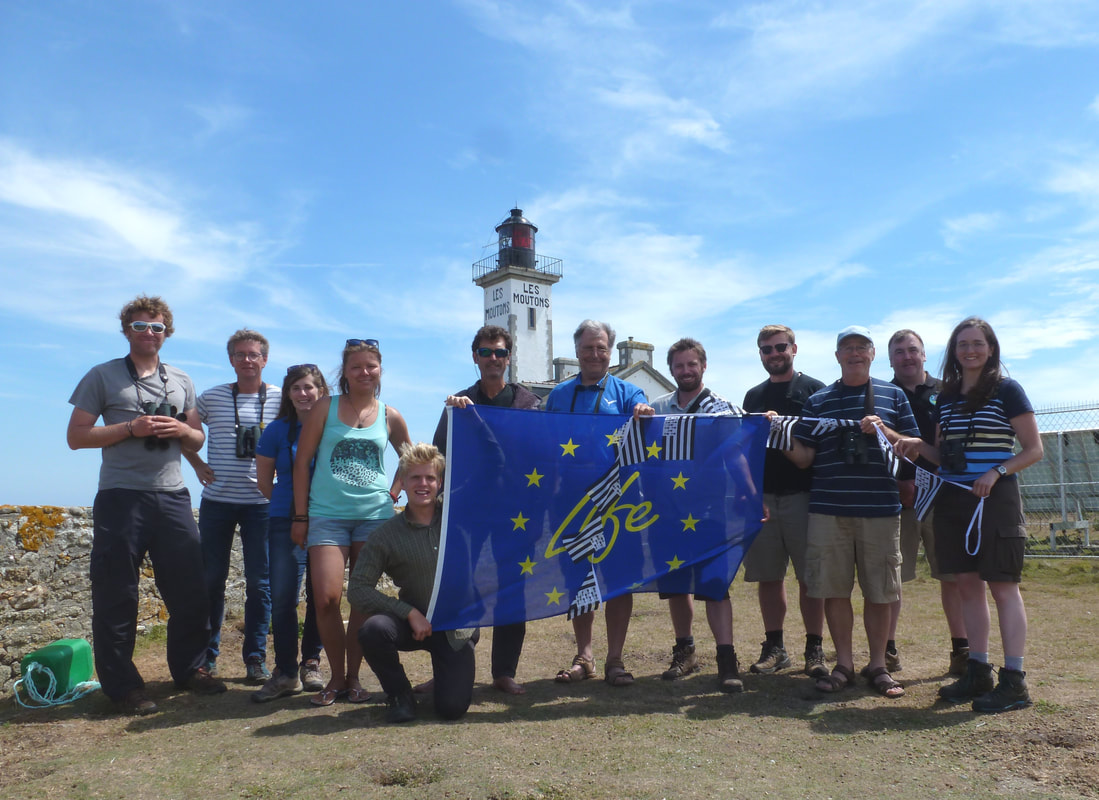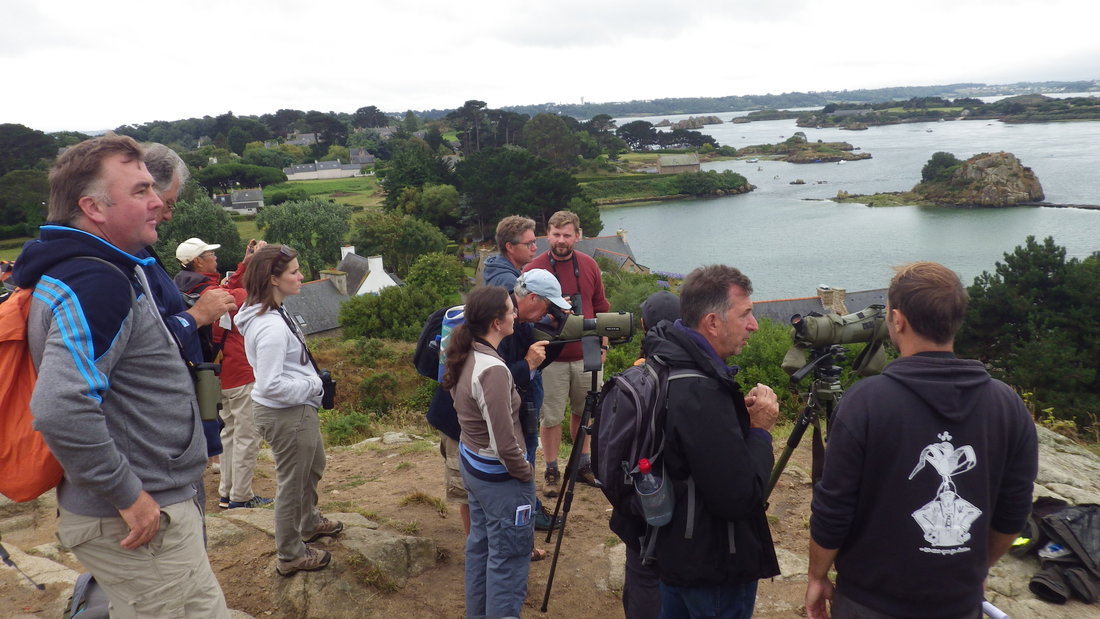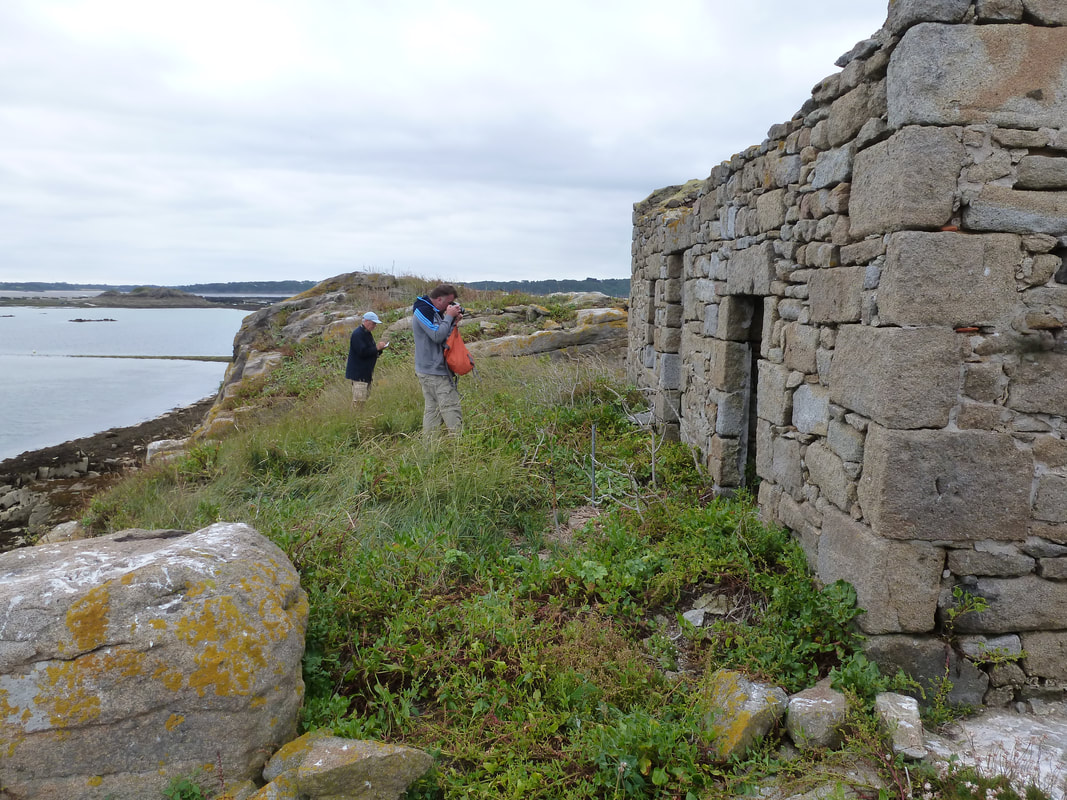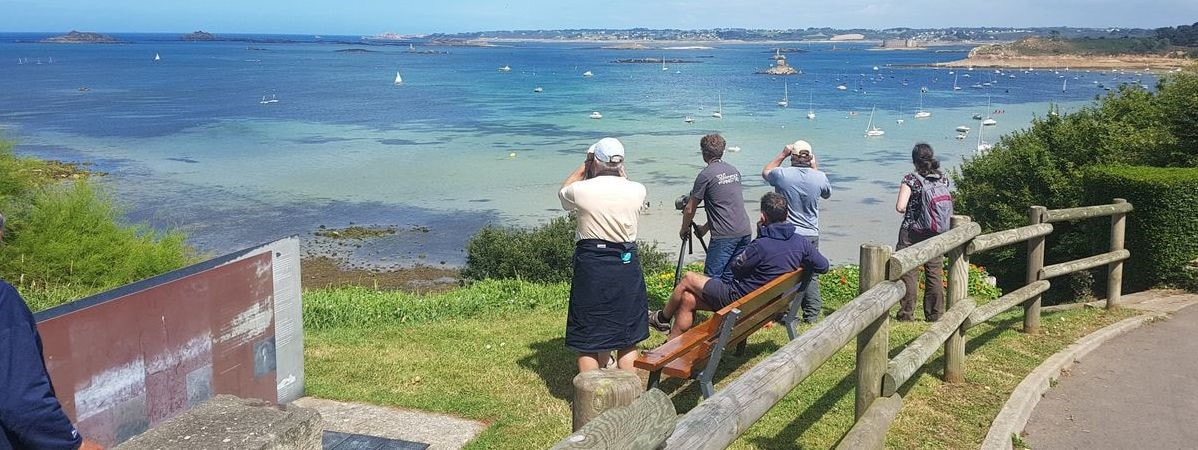|
It has been a busy summer at the three roseate tern colonies with the wardens monitoring and protecting them, but more the 2017 breeding highs and lows in a later blog post. An important part of the Roseate Tern LIFE Recovery Project is information exchange and not only between our UK and Irish colonies and partners. As terns like many animals do not stop at a country's border; understanding movement between sites and protecting these areas is essential. In north-west Europe, of the two other countries that support breeding roseate terns; the closest to the British Isles is France. Breeding roseate terns are located entirely in Brittany and historically their population followed a similar decline to the rest of the Europe. In the past, tern wardens have recorded British and Irish terns nesting in the French colonies; meaning there is obviously some interchange across the English Channel. As a result, in late July several members of the Roseate Tern LIFE staff, BirdWatch Ireland, RSPB and National Parks and Wildlife Services travelled to Brest to meet with Mr Yann Jacobs, Tern Project Manager/Regional Coordinator from Bretagne Vivante and visit the key tern sites.  Ile aux Moutons, an island south of Finistère was our first port of call. Now the stronghold of breeding roseate terns in Brittany, 2017 saw the island supporting 43 pairs. In addition it also had 2552 pairs of Sandwich terns and 271 pairs of common terns. Our visit offered the opportunity to discuss and exchange various management methods used and resulting experiences. (Photo Credit: Chantal Macleod-Nolan)  The monitoring of the tern colony is undertaken by interns/warden who have basic accommodation; small equivalent of a bothy. The island is managed by Bretagne Vivante and Conservation du Littoral. To prevent disturbance during the critical breeding season, parts of the island has been roped off and signage has been erected at a viewpoint which provides a detailed explanation on the various ground nesting shorebirds and seabirds present. (Left to Right: Gaétan Guyot, Yann Jacob, Charlotte Belcher, Léa Daures, Matt Brown, Bruno Ferré, Paul Morrison, Benjamin Callard, Daniel Piec, Steve Newton, Tony Murray, Chantal Macleod-Nolan. Photo Credit: Yann Jacob)  The following morning we visited Ile de Bréhat where we met Yann Février, Delphine Mathérion and Irène Nègre from Groupe d’Études Ornithologiques des Côtes d’Armor (GEOCA). They monitor the terns which nest in the Bréhat and Trégor-Goëlo archipelago. It is a particularly complex site due to the terns nesting on a multitude of islets. The SPA is known to support breeding common terns (38-74 pairs in 2016), Sandwich terns (30 pairs in 2015) and little terns (1 pair in 2015), although their breeding numbers have greatly fluctuated on an annual basis. In addition, roseate terns have been observed nesting in this area intermittently over the years, with the most recent attempt consisting of two pairs in 2015. (Photo Credit: Delphine Mathérion)  Our visit in the afternoon to Ile de la Colombière (which at low tides is connected to the mainland) was delayed somewhat due to a flat tyre. Luckily it happened close to a garage and once replaced, we continued on our quest! On arrival we met the seasonal wardens Elise Soetens and Kevin Dréo, and as a group we progressed to the causeway. (Photo Credit: Yann Jacobs)  The island supports breeding Sandwich terns, common terns, oystercatchers and rock pipits. It is a former breeding site for roseate terns and has been used regularly in the last 10 years (consistently between 2007 and 2014), although numbers fluctuate on a year on year basis. Since 2010, it has been the second most frequent site in Brittany for roseate terns. The conservation bodies managing and monitoring the site are Bretagne Vivante and Conseil départmental Cȏtes d’Armor. As the island is accessible at low tide, human disturbance is also a major threat to the site. There are several signs erected during the breeding season stating that it is an exclusion zone of 100m. (Photo Credit: Yann Jacobs)  The last day of site visits involved getting a boat out to the archipelago of Molène and Ouessant, which represents the second most important area in Brittany for nesting seabirds (after the archipelago of Sept-Îles). We landed on Ile de Litiry, a small island, which has dense vegetation and shingle beaches. It is monitored by Parc naturel marin iroise. Little terns and common terns have been recorded to nest here and during our visit, Dr Steve Newton discovered a storm petrel egg, a new breeding species for the island!! (Photo Credit: Chantal Macleod-Nolan)  Next stop was Ile de Quéménes (Ile de Kemenez) which is managed by Conservation du Littoral. It regularly supports three species tern: Sandwich, little and common. In 2016, 3 to 5 pairs of roseate terns attempted to nest on the island as well. There are two distinct areas where the terns nest. The monospecific little tern colony nests on the south beach of the island, where the substrate is sandy/shingle; whilst the other colony comprising of mixed tern species is located near the jetty on a stony substrate. (Photo Credit: Chantal Macleod-Nolan)  Ile aux Dames was the final site of the trip. Famous for being the main breeding colony of roseate terns from 1983 until 2010; it was a good to hear more about the island's circumstances. The island is monitored and managed by Bretagne Vivante and Conservation du Littoral, with an exclusion zone of 80m around the island to deter humans landing and disturbing the nesting birds. Although anti-predator fencing was successful in preventing mammalian predators, the abandonment of the island by terns was likely due to the persistent pair of peregrine falcons. This island is still an important area as terns may consider recolonising it in the future. (Photo Credit: Daniel Piec) Both Bretagne Vivante's exchange visit to Northumberland and this the LIFE Project's trip to France have been fantastic opportunities; allowing us to get a deeper understanding of the intricacies of the different sites and the management approaches from various organisations. Through the collaboration of organisations which manage roseate tern colonies on an international scale; we can potentially offer new solutions and set a precedent for future activities.
0 Comments
|
More Blogs to Read
AuthorThis blog is maintained by various people from the project team. Archives
August 2020
Categories
All
|
Roseate Tern LIFE Project is supported by the LIFE Programme of the European Union
LIFE14 NAT/UK/000394 ROSEATE TERN
LIFE14 NAT/UK/000394 ROSEATE TERN




 RSS Feed
RSS Feed